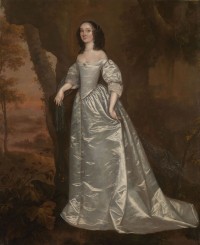 The Tate museum has acquired the earliest portrait in its collection painted by a woman. Portrait of an Unknown Lady (1650-5) was painted by Joan Carlile, one of very few women known to have been a professional portrait artist in 17th century Britain. Museum researchers believe she may even have been the first woman in Britain to be a professional oil portraitist.
The Tate museum has acquired the earliest portrait in its collection painted by a woman. Portrait of an Unknown Lady (1650-5) was painted by Joan Carlile, one of very few women known to have been a professional portrait artist in 17th century Britain. Museum researchers believe she may even have been the first woman in Britain to be a professional oil portraitist.
The unknown sitter’s pose and elegant white satin appear in two of her other known portraits. This repetition of a composition lends weight to the notion of Carlile as a professional artist. In 1653 her neighbour Brian Duppa noted that ‘the Mistress of the Family intends for London, where she meanes to make use of her skill to som more Advantage then hitherto she hath don’ and in 1654 Carlile is recorded as living in London’s Covent Garden, then the heart of London’s artistic community.
Little is known about Joan Carlile’s early life. She was the daughter of one William Palmer, a senior official at St. James’s Park and its Spring Garden, now open to the public as one of the Royal Parks, but at the time still very much the private reserve of the monarch. In 1626 she married Lodowich Carlile, a playwright and courtier who was Gentleman of the Bows, Groom to the King and Queen’s Privy Chamber and Keeper of the Great Forest at Richmond Park to King Charles I. They lived together at Petersham Lodge, a perk of the Richmond Park gig, which is where they were living when Bishop Brian Duppa was their neighbor. He apparently had a high opinion of Mrs. Carlile’s talents. He wrote to a correspondent in early 1654: “I have had a long studied designe of having yr Picture, and by that Hand rather then by any else.”
He wasn’t alone. King Charles I thought highly of her work, and no lesser a figure than court painter par excellence Anthony van Dyck mentored her. Charles gifted them both with nose-bleedingly expensive ultramarine paint. Even after the beheading of Charles I, Lodowich Carlile retained his job as Keeper, which is unusual for someone who was really quite close to the late king since they had gone hunting together frequently. He kept the job throughout the Commonwealth and into the Restoration.
Their stint as bohemians living the Covent Garden life didn’t last long. They returned to Petersham Lodge in 1656. By then she had established her reputation as a portrait painter in society. Historian and courtier Sir William Sanderson included a reference to her in his 1658 survey on the history of art in England, Graphice, The Excellent Art of Painting. He named her first in a short list of four women artists notable for their oil paintings. Mrs. Carlile, says Sanderson, is a “virtuous” and “worthy” example of his maxim “that the ground of all excellencies in this Art is the Naturall fancie bon-esprite, quick wit and ingenuity, which adds and enables the elaborate.”
The couple moved to London again in 1665, this time residing in the St. James’s Market area. Lodowich died there in 1675, followed four years later by Joan. The newly acquired portrait is one of a handful of works by Joan Carlile known to survive.